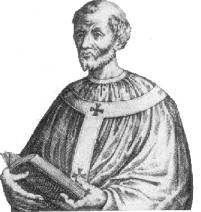 Alexander
IV, originally called Raynold or Roland belonged to the Conti
family. Gregory IX made him cardinal-deacon of Saint Eustace,
and then Bishop of Ostia and Veletri. Conti was elected pope at
Naples, against his will, on the 12th of December, 1254, and
crowned on the 20th of that month.
Alexander
IV, originally called Raynold or Roland belonged to the Conti
family. Gregory IX made him cardinal-deacon of Saint Eustace,
and then Bishop of Ostia and Veletri. Conti was elected pope at
Naples, against his will, on the 12th of December, 1254, and
crowned on the 20th of that month.
In 1255 the new pontiff, who resided at Anagni, there
canonized Saint Clare, of the Second Order of Saint Francis.
The faculty of theology of Paris having decided, in 1250,
that it was not allowable to confess to any priest without the
permission of the parish priest, the Franciscans and Dominicans
appealed from the decision, which they deemed an invasion of the
privilege of the mendicant orders. They were therefore excluded
from that university at the instigation of William of Saint
Amaur, who wrote on this subject a book entitled "On the Perils
of the Latter Times, and the Eternal Gospel of the Franciscans."
This book contained many errors and attacks on the Franciscans;
The Holy Father condemned it, and having, like his uncle,
Gregory IX, taken the friars under his protection, he
demanded their readmission into the university, and restoration
to all the privileges of which they had been deprived. The Holy
Father wrote a very courteous letter to the university, paying
many well-deserved compliments to that illustrious body. "The
school of Paris," says one passage in that letter, "is like the
love of life in the earthly paradise, or like the alabaster lamp
in the house of the Lord." About the same time the pope
confirmed the institution of the University of Salamanca,
founded, or restored, by Alphonso X, King of Castile.
In 1256 the Holy Father approved the order of the Servants of
Mary, or Servites, under the rule of Saint Augustine. William,
Count of Holland, elected king of the Romans, having died in
December, 1255, Alexander threatened to excommunicate the
electors should they elect, as the deceased king's successor,
Conradine, son of Conrad and grandson of the emperor Frederic
II.
The pope ordered that the bishops should be consecrated
within six months after their election. Anxious to reconcile the
Greek and Latin churches, he sent the Bishop of Orvieto to
Theodore Lascaris, but the embassy had not the hoped-for
success.
New disturbances excited at Rome by Manfred obliged the pope
to retire to Viterbo, and thence to another city.
While in that condition of exile, Alexander is said to have
granted privileges with unexampled facility.
King Louis IX continued to govern France with glory, and
daily gave tokens of an exemplary piety. Among all the religious
orders he especially loved the two mendicant orders, the
Dominicans and Franciscans. He said if he could give away his
body, each of those orders should have half of it.
About 1256 Saint Bonaventure began to be famous. He was born
at Bagnara, in Tuscany, in the year 1221. At the age of
twenty-two he entered the order of Saint Francis, and became the
eighth minister-general of that order.
About 1259 Italy witnessed a till then unexampled religious
movement. It commenced at Perugia, and passed thence to Rome and
the rest of the country. Nobles and commons, old and young, even
children only five years old, touched by the fear of God's anger
for the crimes with which Italy was inundated, went about the
streets of the city almost naked. They went in procession, by
two and two, each carrying a leather whip, and, with groans and
tears, so violently beat their shoulders that they were covered
with blood. At the same time they implored the mercy of God and
the help of the Virgin Mary. These Flagellants, socalled, were
suspected by Manfred, King of Naples, even before they were
accused of any errors of faith; and he forbade, under pain of
death, such austerities in any part of his kingdom.
The Holy Father returned from Anagni to Viterbo, to hold a
general council and restore peace between Genoa and Venice, but
fell ill and died in that city on the 25th of March, 1261, after
governing the Church six years, five months, and fourteen days.
He was interred in the cathedral of Saint Laurence.
This biographical data is from
"The Lives and Times of the Popes" by The Chevalier Artaud De
Montor. Published by The Catholic Publication Society of New
York in ten volumes in 1911. The pictures, included in the
volumes, were reproduced from " Effigies Pontificum Romanorum
Dominici Basae."

